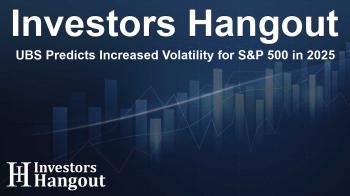UBS Predicts Increased Volatility for S&P 500 in 2025

UBS Anticipates Elevated Volatility for S&P 500 in 2025
UBS has made a significant forecast suggesting that the S&P 500 will experience elevated volatility throughout 2025. This prediction stems from various factors including macroeconomic uncertainties, shifting policy rates, and potential geopolitical risks that could influence market stability.
The End of the Low Volatility Era
According to UBS analysts, the low volatility period observed in 2024 has concluded. They highlight that lingering disruptions from the Covid era continue to affect the global economy, shifting from social or political disturbances to more deep-rooted challenges within business and market cycles.
Global Economic Outlook
The depletion of government stimulus measures is expected to slow down nominal growth, particularly in major economies like China and the US. UBS cautions that regional disparities in economic activity might persist. Notably, these disparities could be exacerbated by varying policy implementations and economic strategies. Interestingly, the gap between services and manufacturing sectors may start to narrow, presenting a unique dynamic for investors.
Historic Patterns of Volatility
UBS strategists observe historical trends where slower nominal growth, coupled with rate cuts, typically leads to increased volatility in the market. This volatility often stems from uncertainties surrounding economic downturns, including rising unemployment or mid-cycle slowdowns. Until clarity emerges around these economic factors, intermittent spikes in market volatility are expected, particularly in reaction to growth-related developments.
Macroeconomic Policies and Tariff Concerns
Speculation around significant policy changes could also contribute to the unpredictability of the economic milieu. Additionally, the potential for escalating tariff tensions may complicate the scenario further, as UBS points out that tariffs can have wide-ranging redistributive effects across various regions, sectors, and companies. Notably, European equities and banks might face vulnerabilities, while the US could experience more uncertainty regarding tariff pass-through dynamics.
VIX Predictions for 2025
UBS foresees the VIX, a critical measure of market volatility, averaging around 20% in 2025, significantly higher than in the previous year. Furthermore, they believe that volatility-of-volatility will remain elevated, with the VVIX expected to average 110% or more. These predictions underline a landscape where market players must navigate through a higher degree of uncertainty.
Profit Growth and Market Correlations
In recent times, a disparity in earnings has become evident, driven largely by substantial profit growth in major US tech companies. UBS anticipates that this divergence will soon align more closely with the broader market, potentially alleviating the pressure that has kept stock correlations low. However, concerns around early 2025 earnings may arise if hyperscaler capex projections fail to meet the aggressive revenue forecasts set forth by companies like NVIDIA.
Conclusion: Preparing for Economic Variability
As such, strategists warn that weaker earnings revisions could lead to increased stock correlations, potentially propelling higher volatility throughout the year. Investors and market participants must brace themselves for an unpredictable year ahead, focusing on adaptability and resilience in their strategies.
Frequently Asked Questions
What factors are leading to increased S&P 500 volatility in 2025?
Increased volatility is anticipated due to macroeconomic uncertainties, changing policy rates, and geopolitical risks affecting the global market.
How is global economic growth expected to change in 2025?
Global economic growth is expected to slow down, particularly in major economies due to depleted government stimulus and continued disruptions from previous economic conditions.
What role do tariffs play in market uncertainty?
Tariffs can lead to significant redistributive effects across regions and sectors, adding layers of complexity and unpredictability to the economic outlook.
What is the expected average VIX for 2025 according to UBS?
UBS expects the VIX to average around 20% in 2025, marking an increase compared to 2024's averages.
How might tech earnings influence market volatility?
Weak earnings revisions in the tech sector could increase stock correlations, potentially resulting in higher market volatility as the year progresses.
About Investors Hangout
Investors Hangout is a leading online stock forum for financial discussion and learning, offering a wide range of free tools and resources. It draws in traders of all levels, who exchange market knowledge, investigate trading tactics, and keep an eye on industry developments in real time. Featuring financial articles, stock message boards, quotes, charts, company profiles, and live news updates. Through cooperative learning and a wealth of informational resources, it helps users from novices creating their first portfolios to experts honing their techniques. Join Investors Hangout today: https://investorshangout.com/
Disclaimer: The content of this article is solely for general informational purposes only; it does not represent legal, financial, or investment advice. Investors Hangout does not offer financial advice; the author is not a licensed financial advisor. Consult a qualified advisor before making any financial or investment decisions based on this article. The author's interpretation of publicly available data shapes the opinions presented here; as a result, they should not be taken as advice to purchase, sell, or hold any securities mentioned or any other investments. The author does not guarantee the accuracy, completeness, or timeliness of any material, providing it "as is." Information and market conditions may change; past performance is not indicative of future outcomes. If any of the material offered here is inaccurate, please contact us for corrections.
